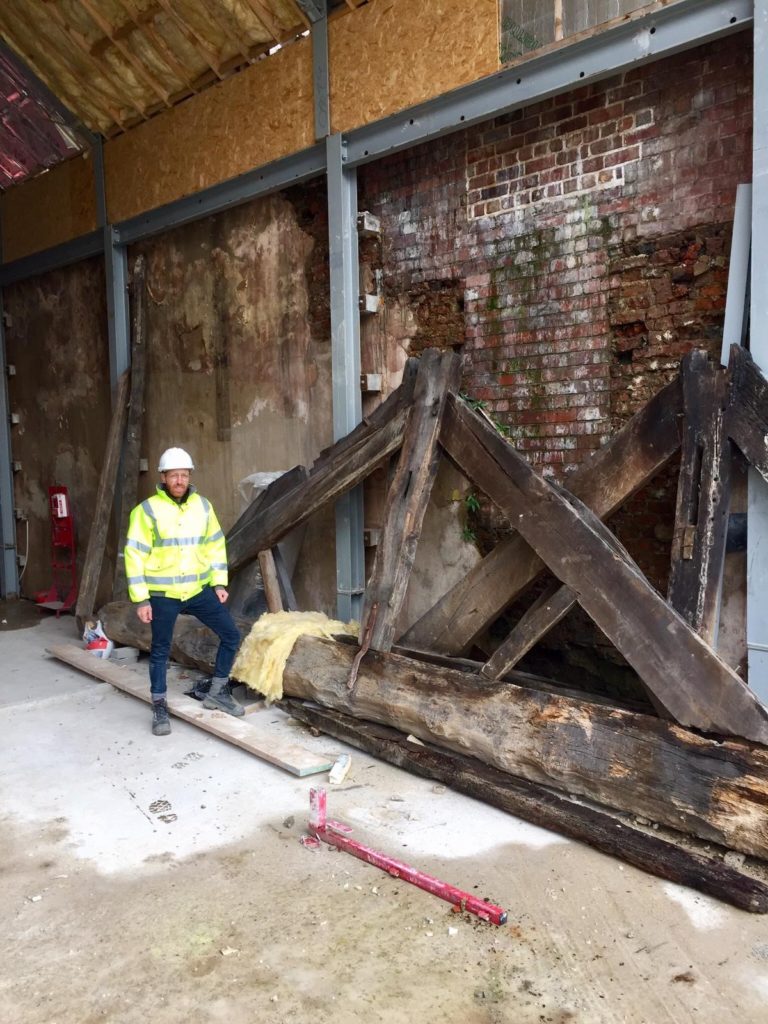
Builders find oak timbers thought to be 1,000 years old inside First White Cloth Hall in LeedsJanuary 7, 2021Contractors working on the renewal of the oldest building in Leeds city centre have discovered oak timber joints that could be almost 1,000 years old. The wooden ‘trusses’ were used in the construction of the First White Cloth Hall in 1710, having come from trees that had been felled in 1470, and were used in another building before being ‘recycled’. Carbon dating techniques called dendrochronology have established that the wood could be even older, and that the oaks may have been planted as early as 1200AD, making them already 200 years old when they were cut down for timber. The stunning discovery is the latest of several archaeological finds made at the site on Kirkgate since developers Rushbond and their partners began renovating the First White Cloth Hall in the Spring of 2019. It is due to be completed in March. Last autumn, builders found a pit, sump and keystone within the structure that were several hundred years old. A keystone is a wedge-shaped stone found at the apex of a masonry arch, and is the final piece placed during construction which fixes the other stones in position. They often have a decorative role. Sumps were spaces beneath buildings that were used for drainage. Rushbond’s plans for the Grade II listed building, which has been on Historic England’s At Risk register since 1999, include rebuilding the west wing and creating a large assembly room. The public courtyard will be enclosed and a new cube will link the site to the Corn Exchange. They hope First White Cloth Hall will be leased to a retail store, cultural business or leisure operator. Conservation architect Grant Prescott, who has been working at the site, said: “At the start of the project there were six oak trusses and associated roof timbers still in place in the existing building, while other trusses had been moved to off-site storage after the demolition of the west wing of the building in the early 2010’s”. Mr Prescott’s firm, Buttress Architects, has worked with Historic England and Leeds City Council to develop a design that incorporates the trusses within the restoration project. He added: “When construction began, it was clear that the existing structure was in a perilous state. The contractors have painstakingly and carefully removed the trusses to store them safely off-site – this has allowed the historic brick and stone walls to be stabilised and incorporated into the final scheme”. WYAS Archaeological Surveys were then engaged to record the ancient materials found within the structure. “The analysis has found that whilst there are trusses that date to the original construction of First White Cloth Hall in 1710-11, there were others that could potentially be traced back to the mid-14th century, much earlier than FWCH’s construction – a highly significant discovery. “The vernacular nature of the timber can be seen in their hand-sawn undulating forms. In light of this, it was seen as vitally important that those timbers are rescued, and the team has worked together to incorporate these within the scheme. Due to decay, the trusses will not perform a structural function, but as part of the completed building will provide a fascinating insight into the remarkable historical story of First White Cloth Hall”. Rushbond’s director of real estate Mark Finch added: “The First White Cloth Hall is like a library that holds a collection of great stories – this is just one of many, but what a great story it is! “It’s amazing to think that such timbers could survive all these years. The team’s efforts to save and restore have equally been amazing. Stories come alive when there is something tangible to see and the ability to bring these timbers back into the building makes you want to know more. The research that has been undertaken has helped unlock a story to be told for the benefit of future generations”. What is the First White Cloth Hall? The 18th-century building, the oldest in Leeds, was a cloth trading exchange built for merchants. Incredibly, there have been four White Cloth Halls in Leeds during the history of the textile industry. The First fell out of use when the Second White Cloth Hall was built in Holbeck to replace it. This building was used for just 20 years before the Third White Cloth Hall, which was much grander, opened on Crown Lane. In 1865, the third incarnation had to be partially demolished to make way for the North Eastern Railway, who were required to fund a replacement Fourth White Cloth Hall on King Street. The decline in the cloth trade meant this building was never heavily used and it was razed in 1895. The Hotel Metropole was later built on the site. The original White Cloth Hall was the only survivor, and it was used for several purposes before its condition began to deteriorate. By the 1960’s, it was mostly vacant and it was completely disused by 2010. In 2011 part of the First White Cloth Hall site had to be demolished when a neighbouring building collapsed. The previous owners were unable to restore it due to heavy conservation costs and at one point it was feared the hall had degenerated so much that it would have to be knocked down. Historic England had campaigned for years to save it, arguing that the building was the ‘birthplace’ of the city’s economy. Rushbond bought it in 2017, and contractors HH Smith and Sons Ltd began work in March 2019. |



